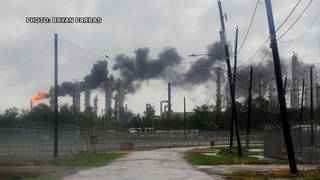
Guests
- Jessica LeeDemocracy Now! social media coordinator.
We get a live update from Red Hook, Brooklyn, a neighborhood near the New York City harbor where residents evacuated in the face of flooding — even though they live about 10 feet above sea level. “What we saw last night was that the surge swept in throughout basically the entire neighborhood,” says Jessica Lee, social media coordinator for Democracy Now!, who lives in the area. She describes water levels of at least five feet that moved cars off the street and onto the sidewalk, and says many surfaces are covered with an oily sheen. [includes rush transcript]
Transcript
AMY GOODMAN: This is Democracy Now!, democracynow.org, The War and Peace Report. I’m Amy Goodman. We’re broadcasting on the Superstorm Sandy. Right now, the latest news is that President Obama has declared New York City an emergency area, a number of counties around it, declaring a federal disaster area New York City, Long Island, eight counties in New Jersey, the declaration making federal money available to deal. CNN now confirming that it incorrectly reported that there were three feet of water on the floor of the New York Stock Exchange. The exchange remains closed. All bridges and tunnels out of Manhattan have been closed.
We’re going to go right now to Red Hook, to Democracy Now!’s Jessica Lee, where she lives.
Jessica, describe where Red Hook in Brooklyn is and what you’re seeing right now, what you’ve experienced over the last day.
JESSICA LEE: Hi, Amy.
Well, I live in Brooklyn in a neighborhood called Red Hook, and Red Hook is in southwestern Brooklyn. And if you know where the Statue of Liberty is, it’s the closest neighborhood to that. So, we enjoy a lot of oceanside parks down here in Red Hook. It’s a residential and industrial mixed neighborhood. There’s a lot of artists down here, as well as mixed-income. But we’re very low. In fact, I think the neighborhood rests pretty much all under 10 feet above sea level. So, this was all Zone A evacuation zone, and a lot of people did leave, but a lot of people did not leave. I left and stayed just on the edge of Zone D so I could stay close. And what we saw last night was that the surge swept in throughout basically the entire neighborhood.
I’m actually down here right now. The water has receded. It receded, residents are telling me, about 1:00 in the morning. But it got at least over five feet down here, and cars were floating and moved around. I talked to a resident who had just pushed his car off of the sidewalk. And I ran into my landlord, actually, and we sat down. She just started crying. She stayed there all night and was terrified and said she had five feet of water in her basement. And just there’s people just, you know, pouring out of the buildings here, walking around, trying to figure out what to do. There’s no power, obviously, so nobody could really open the gates inside their building and get inside. There’s a lot of power lines down.
AMY GOODMAN: Jessica, is there a—is there a smell to the water?
JESSICA LEE: Yeah, it’s very oily down here. In fact, you can see oil on the street, as if it was coated with oil, the rainbow sheer look. And it does smell like oil. But right now, there’s—there’s water coming up the street again, because it’s high tide, I believe, around 9:00 a.m. So that’s coming up. And I don’t think it’s expected to seep back into the whole neighborhood, but it is down at the very end of the street called Van Brunt Street, at least a few inches thick.
AMY GOODMAN: Jessica, I want to thank you for that eyewitness report on the ground in Red Hook, Brooklyn, along the water. Also want to mention our website report on New York City’s decision not to evacuate Rikers Island, which is home to some 12,000 prisoners, and also want to recommend to people to go to democracynow.org to hear our report with Patrick Elie in Haiti, still the hardest-hit, reports Haiti could face a food shortage after the storm, death toll—well, we should—85 people confirmed dead in total throughout the Caribbean.














Media Options